INTRODUCTION
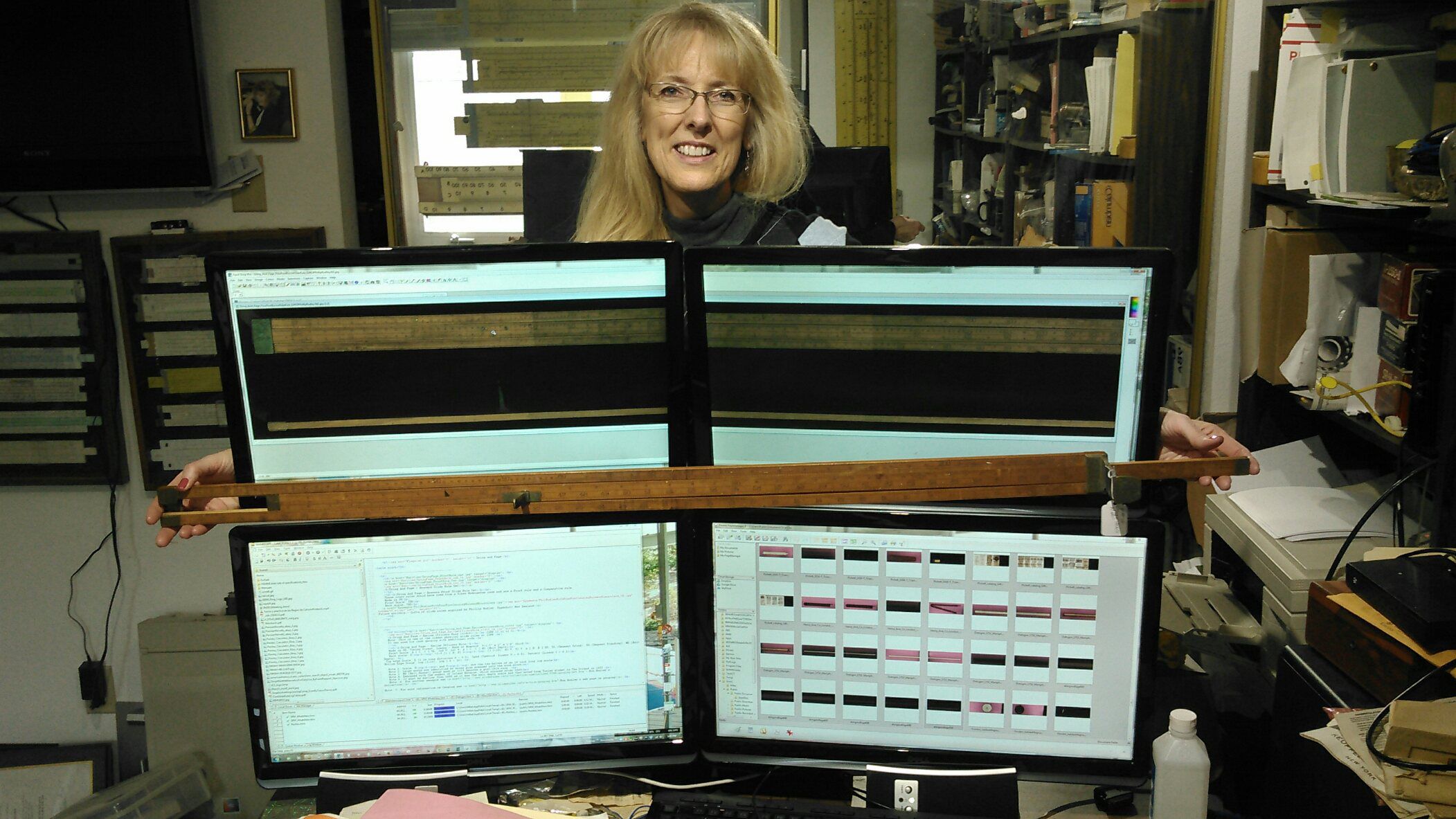

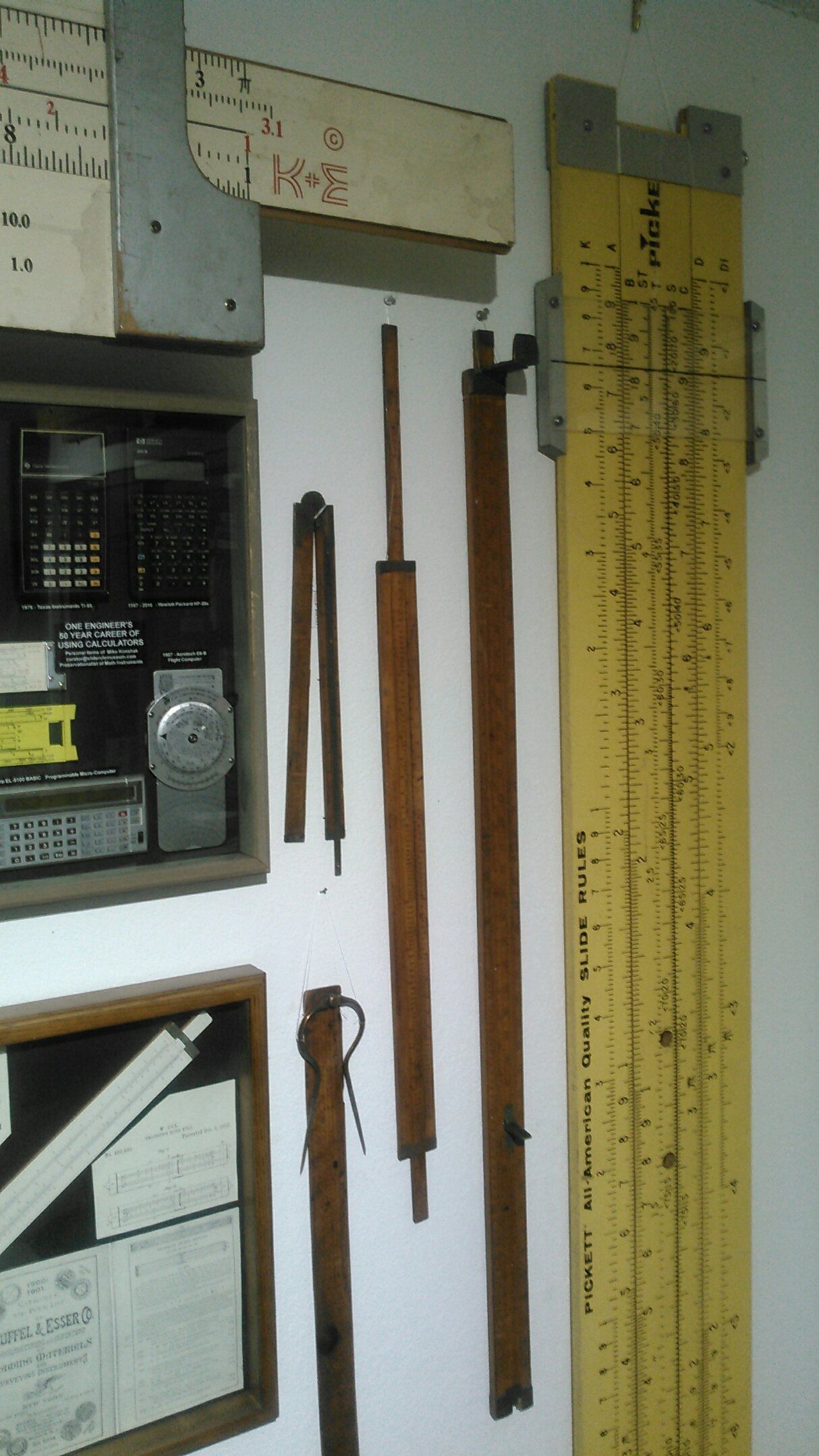 ISRM is the world's largest free digital repository of all things concerning slide rules and other math artifacts. There are over 7000 Images or PDF's in the ISRM Galleries and Libraries. The picture of Becky holding a 1903 4 foot Ding & Frage Excise rule in front of quad monitors, shows the ISRM archiving operation, and the 17" x 11-1/2" (A3) scanner that is used.
There are scans or pictures of actual slide rules and related math arifacts in the museum or provided by collectors from around the world Every specimen is
different in some way. Duplicate model numbers in this collection have different cursors, scales, logos or construction features. Unlike
most collectors who want pristine specimens, the curator enjoys getting slide rules that are marked
with the original engineer's name especially when we are told what work they were used for, even if it only helped the owner get through college.
ISRM is the world's largest free digital repository of all things concerning slide rules and other math artifacts. There are over 7000 Images or PDF's in the ISRM Galleries and Libraries. The picture of Becky holding a 1903 4 foot Ding & Frage Excise rule in front of quad monitors, shows the ISRM archiving operation, and the 17" x 11-1/2" (A3) scanner that is used.
There are scans or pictures of actual slide rules and related math arifacts in the museum or provided by collectors from around the world Every specimen is
different in some way. Duplicate model numbers in this collection have different cursors, scales, logos or construction features. Unlike
most collectors who want pristine specimens, the curator enjoys getting slide rules that are marked
with the original engineer's name especially when we are told what work they were used for, even if it only helped the owner get through college.
-
The prefix codes 'S0XX', 'P0XX', 'L0XX', 'MXX', etc were the original identification filing system created by Michael Konshak and are not part of manufacturer's
model numbers. Slide rules with this notation are no longer part of the active ISRM collection as they were gifted to the Computer History Museum.
They may be replaced when a matching specimen arives at our door.
-
The 'ISRM' prefix code means the specimen is part of the physical current collection, owned by ISRM 501(c)3, and may have been claimed as a tax deduction.
All slide rules were given this code along with an accession/reference number of the form YY.MM.DD.NN. (Year, Month, Day, Number).
Note: if an "X" is on the end, then that specimen has been deaccessioned and is no longer in the collection either sold, gifted or scrapped.
The digital image and provenance is still retained at the discretion of the curator.
-
The 'MVK' prefix code means the specimen is part of the physical current collection on loan to ISRM from the MIchael Konshak Collection.
All acquisitions by Michael Konshak (MVK) were given this code along with the standard accession/reference number of the form YY.MM.DD.NN. (Year, Month, Day, Number).
Note: if an "X" is on the end, then that specimen is no longer in the MVK collection, either sold, gifted or scrapped. The digital image and provenance is still retained at the discretion of the curator.
-
The 'HSRC' prefix code are slide rule images from Herman's Slide Rule Catalogue
which are duplicated in the HSRC gallery.
-
The 'REF' prefix code denotes that this is a donated scan from an ISRM friend or other source that has
been archived on this site..
-
When you click on the pictures you will get a 150 dpi FULL SIZE SCAN (note manuals are scanned at 200 dpi)
of the slide rule.
-
Scales are listed as to the location on the slide rule. The FRONT side is arbitrarily determined by
the presence ofthe most common scales A [B, C] D.
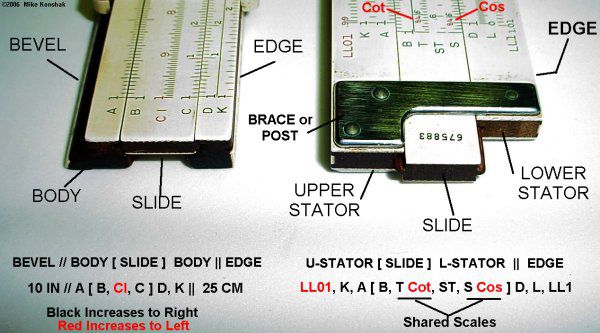
Scales are described using the above convention
This is a work-in-progress. The ISRM website is being expanded constantly to add reference
pictures of slide rules and ephemera provided from other collections and international sources as well as from new acquisitions acquired through donations. Some scans are being supplied by other
collectors who use the site as a reference, credits are duly noted, when known. Electronic 'Slide Rule' Calculators and Abaci are the newest galleries being documented at ISRM. The website pages are constantly being updated to become more mobile-friendly with drop-down buttons.
MISSION STATEMENT
This collection of mathematical artifacts has taken quite a while and expense to
accumulate and catalog. Consequently, my goal as the curator, was to not only
provide research information at no charge to the public but also assist worthwhile
educational and historical institutions in expanding their collections. So far,
recipients have been the University of Colorado, the Math History Museum of the
Smithsonian Institute, and the Computer History Museum.
DONATIONS (GIFTS) OF SLIDE RULES - PLEASE READ
As of June 30, 2024, ISRM will no longer be acquiring or accepting gifts of slide rules as there is a large backlog of artifacts waiting to be scanned and posted to the on-line galleries.
ISRM is also in the process of down-sizing (deaccessioning) parts of the physical collection, which includes both duplicate and one-of-kind specimens.
This does not affect the digital collection. The provenance of past donations will continue to be preserved on this website. This effort will also be used to fund the future of the website and ongoing storage of the remaing archive, making ISRM less reliant on monetary donations.
Museums and individual collectors interested in participating in this effort that wish to obtain any of the specimens shown in the galleries through a monetary donation, may contact the curator via email for consideration. Thank you for your support.
Past donors and supporters please review the following document:
ISRM Future of Accessioning, Deaccessioning, Transfer & Disposal (.PDF) Revised 05-04-2023
|
Please contact:

1944 Quail Circle
Louisville, CO 80027
United States
 ISRM Deed of Gift Form (.pdf) ISRM Deed of Gift Form (.pdf)
 ISRM Deed of Gift Form (.doc) ISRM Deed of Gift Form (.doc)
|
MONETARY DONATIONS (GIFTS)
All the high resolution images of slide rules in the galleries and the PDF files of
scanned books, manuals and instructions have been free to download since 2003. The policy of ISRM is to
continue this practice, without restrictions in order to provide research and educational information
to the world at large. However, running a web site of this size with a large amount of data does take a
lot of time and effort and does incurr costs in hosting in order to provide the bandwidth. If you have
enjoyed the many offerings of ISRM, and would like to contribute toward its expansion, you can send
money using the Secure Paypal button on the right. All monetary contributions will be used to pay for the
web site service, support shipping for the Slide Rule Loaner Program.
Thank you for your support and consideration!
Please make personal checks or Money Orders payable to: Michael Konshak
|
To contribute
toward downloads:
KEEP ISRM FREE!
|
PRIVACY STATEMENT
ISRM does not collect any information concerning any of its visitors.
In the case of Paypal transactions, only Paypal has access to your
information.
HISTORY OF ISRM
The International Slide Rule Museum began as a one-man's collection of slide rule as was shown on Michael V. Konshak's personal website, "konshak.com" which became defunct in 2006 .
As the ISRM website grew in numbers, Michael envisioned a future of having a brick-and-mortar museum, either as a standalone entity or
as part of an existing physical museum. The sliderulemuseum.com website was created in 2003 as a mechanism to began the process of fulfilling that goal.
Part of having a complete collection relies on having artifacts of that would be interesting to visitors. Many supporters expressed a desire to deduct donations on their I.R.S. taxes. In response to these requests, in 2018,
ISRM became incorporated in the State of Colorado and were given an official non-profit status by the I.R.S. and has a Board of Directors.
ISRM, LLC is still a one-man operation with Michael Vaughn Konshak as the President and Curator.and the corporation has a
Board of Directors and Friends of the Museum as a Board of Advisors. The entire Michael Konshak collection is on loan to ISRM. The future of ISRM is uncertain, as the hopes of the collection
to be hosted and displayed in a brick-and-mortar museum has diminished. Most likely, the best we can hope for is to preserve the images of the specimens
and maintain a virtual museum via the website, but with the intent of making the website more modern and mobile friendly. The physical artrifacts that are on loan to ISRM, and those belonging to ISRM, most likely
will have to be transferred or sold on a piecemeal basis.. The 501(c)3 status of ISRM , LLC may be terminated in the future at the discretion of the Board of Directors when monetary donations are no longer needed. At that time, the website will continue to be maintained by Michaael Konshak, or a successor familiar with writting HTML code..
* Hairy-Eared Engineer - definition:
1) An engineer who's old enough to have hair growing out of undesirable places.
2) Who's been
practicing engineering so long that he or she has already made all possible mistakes at least once.
3) A desirable person to have on a project to ensure the mission succeeds.
4) Quote: "Every
project needs at least one hairy-eared engineer" Marvin B. Davis -1980.
(Marvin was one
then and 34 years later, my barber can attest that I've finally made the grade).
|
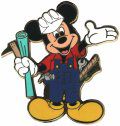
|
|

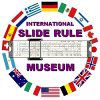
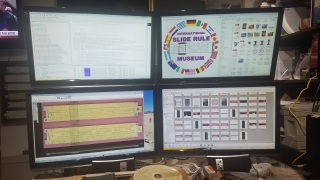
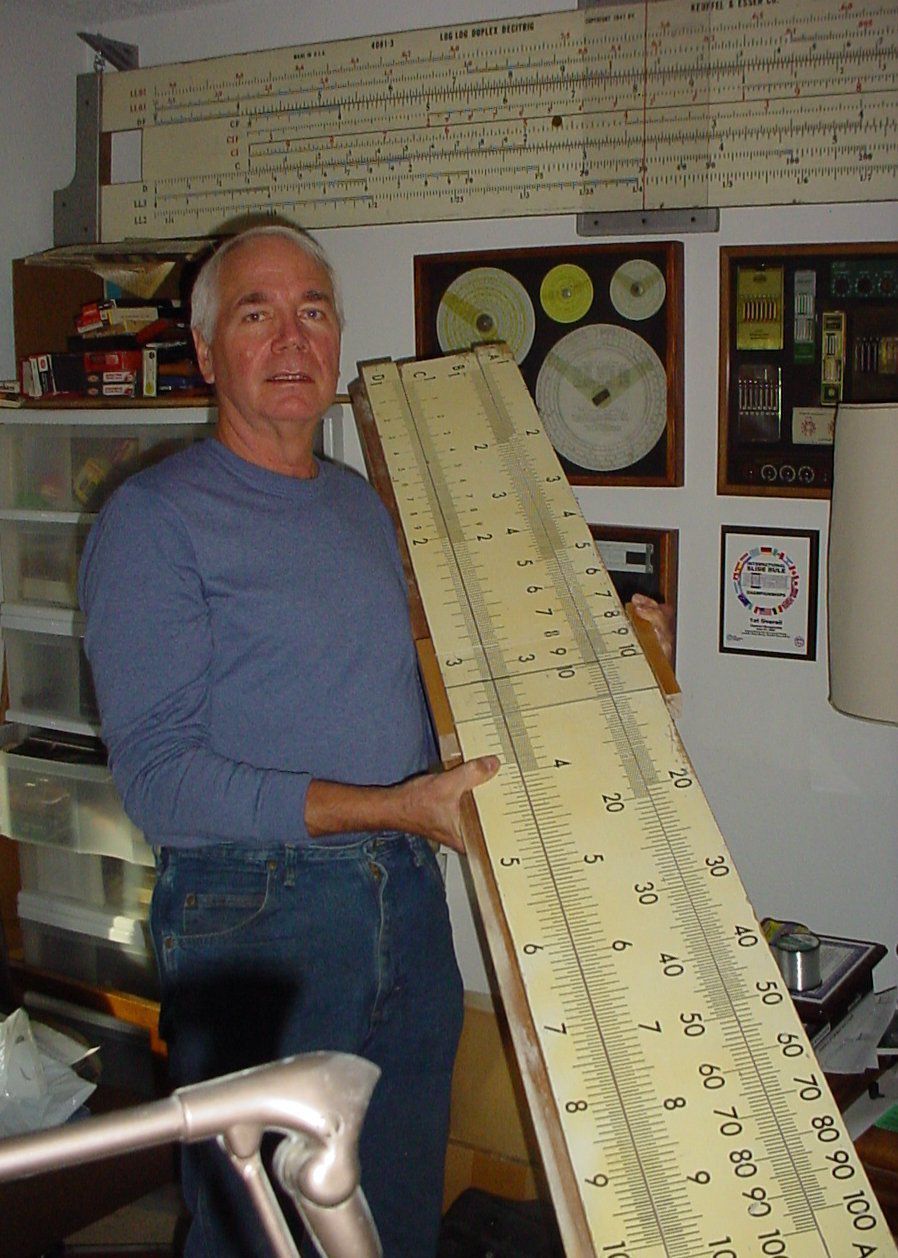
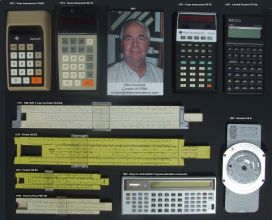
 Calculators Before The CPU
Calculators Before The CPU




 ISRM Deed of Gift Form (.pdf)
ISRM Deed of Gift Form (.pdf) ISRM Deed of Gift Form (.doc)
ISRM Deed of Gift Form (.doc)